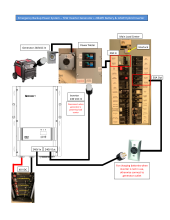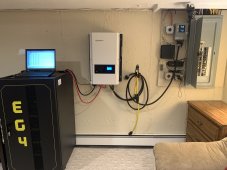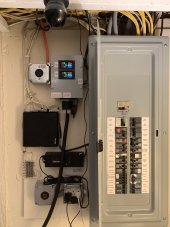Hi folks - brand new to this forum and to Will's youtube channel - amazing content.
Brief Context & Goal: I'm looking for some input on how I'm planning on getting started here. My home is on the grid and I have no backup power currently (no generators/no solar/no batteries/etc). I have what I would consider a reasonably complex, high load electrical system with 1x main panel with a sub-panel and then another panel that electricians have called a "disconnect" from the main panel. My goal ultimate goal is to work up to an automatic battery system that's able to provide emergency power to my most important circuits, but I'm also ok (and likely prefer while I'm learning) to start smaller/more simply.
I've explored solar arrays, but the company I consulted didn't offer battery systems and even seemed surprised I would want one. Google's Project Sunroof tells me I get "1,590 hours of usable sunlight per year." Given the estimated payback period of over 30 years and my house's reasonable amount of shade, I wasn't impressed with their system.
Current Plan: Initially, I may start with an Anker 767 and some portable solar panels. This would provide UPS to my server/router/wifi rack and offer an emergency power option for my fridge and other essentials. The solar panels would charge the device during prolonged blackouts (thinking I would temporarily set them up in my driveway in these situations).
Long-term Plan: Eventually, I want to install a permanent solution tied into my critical circuits directly. We honestly have had very few power outtages that last longer than a few hours since I've lived here, but I want the peace of mind that I have multi-day backup options for when those outages inevitably occur.
Given what the solar folks told me, it doesn't sound like a solar system would ever be my primary power source, but would be interested in possibly some panels to provide emergency backup to keep the batteries charged in a prolonged outtage. I could also be convince that a NG or multi-fuel generator might fit into my system for charging the system during a VERY long outtage. I'm very open to some of these DIY brands/systems and can see myself geeking out over certain components, but I would almost certainly pay an electrician to wire anything into my main panels. After that, I could see myself getting comfortable working on the batteries/inverters upstream from that over time.
There seem to be a TON of options out there and I'm trying to sift through them. I would greatly value your input on:
Brief Context & Goal: I'm looking for some input on how I'm planning on getting started here. My home is on the grid and I have no backup power currently (no generators/no solar/no batteries/etc). I have what I would consider a reasonably complex, high load electrical system with 1x main panel with a sub-panel and then another panel that electricians have called a "disconnect" from the main panel. My goal ultimate goal is to work up to an automatic battery system that's able to provide emergency power to my most important circuits, but I'm also ok (and likely prefer while I'm learning) to start smaller/more simply.
I've explored solar arrays, but the company I consulted didn't offer battery systems and even seemed surprised I would want one. Google's Project Sunroof tells me I get "1,590 hours of usable sunlight per year." Given the estimated payback period of over 30 years and my house's reasonable amount of shade, I wasn't impressed with their system.
Current Plan: Initially, I may start with an Anker 767 and some portable solar panels. This would provide UPS to my server/router/wifi rack and offer an emergency power option for my fridge and other essentials. The solar panels would charge the device during prolonged blackouts (thinking I would temporarily set them up in my driveway in these situations).
Long-term Plan: Eventually, I want to install a permanent solution tied into my critical circuits directly. We honestly have had very few power outtages that last longer than a few hours since I've lived here, but I want the peace of mind that I have multi-day backup options for when those outages inevitably occur.
Given what the solar folks told me, it doesn't sound like a solar system would ever be my primary power source, but would be interested in possibly some panels to provide emergency backup to keep the batteries charged in a prolonged outtage. I could also be convince that a NG or multi-fuel generator might fit into my system for charging the system during a VERY long outtage. I'm very open to some of these DIY brands/systems and can see myself geeking out over certain components, but I would almost certainly pay an electrician to wire anything into my main panels. After that, I could see myself getting comfortable working on the batteries/inverters upstream from that over time.
There seem to be a TON of options out there and I'm trying to sift through them. I would greatly value your input on:
- My initial and long-term plans
- Any research paths and recommendations you might have for me.






